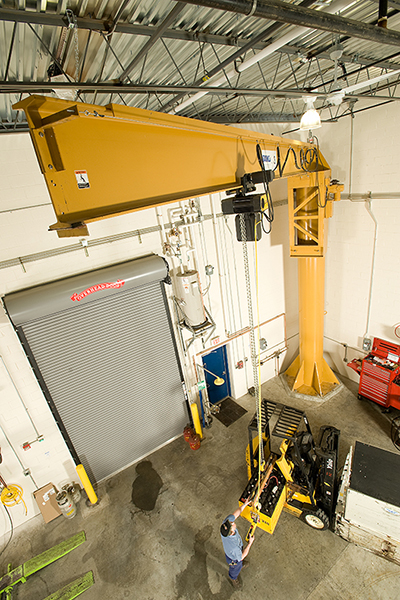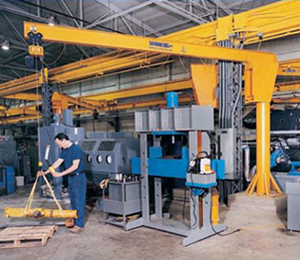Safety When Installing A Foundationless Jib Crane
Don't pity the fool, make sure you follow these guidelines

You want to move heavy loads safely and effectively while also keeping your solution economical and efficient. Consider the Jib Crane, and effective tool in your warehouse arsenal that will hold its own and can interface with a wide variety of workstations and functions.
Foundationless Jib cranes offer versatility and economic savings, as they are bolted directly to an existing concrete floor and don’t require a concrete foundation. Using the existing floor means that you don’t need to install a costly special foundation, plus you can install and use the system sooner because you don’t need to wait for concrete to cure. Existing floor use also makes sense for smaller capacity and shorter span jib cranes. With that said, there are multiple concrete considerations before you install a foundationless jib crane. The key, is your installation.
With two foundationless Jib Crane choices (base plate mount and sleeve insert), you have the options you need to add this handy machinery to your warehouse. But what do you need to consider before installation?
Below are some questions to ask before you make a purchase
Can my floor handle the load?
Concrete is very brittle and has virtually no strength when loaded in tension, so great care must be taken to keep workers safe before bolting any crane to a concrete floor. Concrete, when overloaded, can crack and catastrophically break, which can result in dropped loads or, worse, the crane falling over. Before a foundationless jib crane is chosen, calculations must be performed to ensure that the existing concrete floor can safely handle the crane’s rated capacity. These calculations ensure that your workers are safe from catastrophic concrete failures.

Is a second opinion needed?
Does the crane manufacturer’s sales literature state that the “customer is responsible for determining concrete strength”? If that’s the case, you will need to hire a local structural engineer to perform all the calculations required to determine if your existing concrete fulfills all the safety requirements of the International Building Code (IBC).
Are the specs correct?
There are multiple factors regarding the installation of your jib crane that will require referencing the manufacturer’s specifications. They include:
- Minimum requirements – Has the crane manufacturer specified the minimum steel reinforcement thickness, diameter, and spacing required to keep your workers safe? Concrete requires a minimum amount of steel to strengthen the concrete and keep it safe from catastrophic breaking during use. Not supplying enough steel reinforcement or using a thin, wire mesh can lead to a sudden and complete failure of the concrete. If the steel sizes are not specified, it is most likely because you are responsible for performing the proper calculations to determine the safe amount of steel required to keep your workers safe.
- Reinforcement locations – Has the crane manufacturer specified the proper steel reinforcement location and elevation required to strengthen the concrete properly and keep your workers safe?
- Amount of concrete space needed – Is there a listed the minimum length, width, and square footage of concrete required to keep your workers safe? Cranes require a proper amount of concrete counterweight to stay safe and stable during use. Not supplying enough counterweight can lead to an unsafe and unstable condition.
- Distance from cracks and/or seams – Is the minimum distance the crane can be installed from a crack or concrete seam been identified by the manufacturer? The closer a crane is mounted to a seam or crack, the weaker the concrete. The minimum safe distance must be specified in all cases to keep workers safe.
- Bolt strength – Has the crane manufacturer specified the minimum bolt pull-out strength? This must be listed to ensure the safety of your installation.
Finally, if in doubt, ask the foundationless jib crane manufacturer if they have the calculations performed to the International Building Code that proves the safety of the concrete floor they suggest.
See Also:
Tags: warehousing, Manufacturing, industrial safety, warehouse, Safety & Ergonomics, cranes, jib crane
Evan Fleishacker




